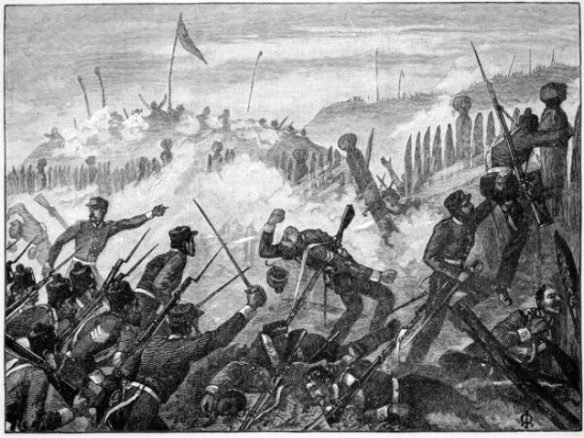SKETCH.
EXPLANATORY OF THE CONSTRUCTION OF MAORI RIFLE PITS.
Note. The interiors of the covered Pits were lined with Fern &c. and used as sleeping places. Food was also cooked in them.
J. R. Jobbins.
Matarikoriko, one of the pas (forts) comprising the main Maori stronghold on the Waitara River in New Zealand’s Taranaki district, was besieged by troops under Major-General Thomas Pratt (commander-in-chief of British forces in Australia) on 29-31 December 1860. Located eight kilometres from the sea, on the river’s southern shore, it was the first-encountered of three formidable fortifications sited on the Kairau plateau and was accordingly the first tackled by Pratt when he took to the field on 28 December. Moving up with 900 men and four guns, the next day the British began constructing a redoubt able to accommodate 500 men about 730 metres from the Maori positions. This was intended to serve as a depot and start-point for a sap to facilitate an attack against the pa, and also for an attack on the next Maori work at Huirangi.
Under a brisk fire from well-concealed rifle pits less than 150 metres away, the British troops laboured all day and received little rest during the night from incessant Maori harassing fire. The exchange of fire on this day was remarkably heavy, with the British alone using an estimated 70,000 bullets along with 120 artillery rounds. The next day, Sunday, a white flag was flown over the stockade and its defenders insisted that they did not wish to desecrate the Sabbath by shedding blood. An armistice was accordingly arranged for the rest of the day, although this did not stop the British from working to finish and improve their redoubt’s parapets, and in preparing barbettes and platforms for mounting two 8-inch guns. Next morning it was found that the Maoris had abandoned the pa, leaving twelve of their dead buried within it. The cost to Pratt’s troops had been three killed and twenty wounded.
The action is principally of note because of the involvement in the British force of a naval brigade of 138 officers and men. Included in this corps were two officers and 30 sailors from the Victorian government’s auxiliary-screw warship Victoria (variously described as a barque, sloop or corvette), this being the first military operation carried out by any Australian armed unit overseas.
James Cowan (1922-23) The New Zealand Wars, 2 vols, Wellington, NZ: W. A. G. Skinner; Tom Gibson (1974) The Maori Wars, Wellington, NZ: A. H. & A. W. Reed; Colin Jones (1986) Australian Colonial Navies, Canberra: Australian War Memorial
